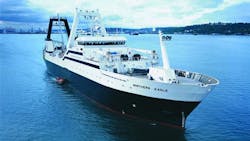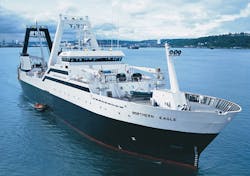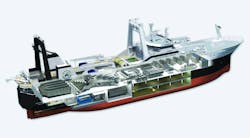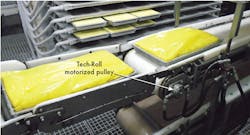A Floating Fish Factory
This file type includes high resolution graphics and schematics when applicable.
American Seafoods Co., Seattle, is the largest supplier of pollock in the world. Mature pollock can grow to 3-ft. long and weigh more than 40 lb., but average 1 to 2-ft. long and weigh ½ to 2 lb. The Alaskan variety is widely used in fish sandwiches offered by major fast-food companies, primarily because of its mild taste. And far off the coast of Alaska is where you’ll most likely find the Northern Eagle cruising the cold, deep waters of the Bering Sea for pollock.
At 104-m long and 15-m wide, the Northern Eagle is the largest ship in American Seafoods’ fleet. It is also among the most modern trawler in North America. It has a crew of 140, with 90 working below deck to process as many as 54,000 fish per hour into 160 tons of finished frozen product per day.
Point-of-Catch Processing
Nearly two-thirds of the space below Northern Eagle’s main deck is occupied by fish-processing machinery. This includes six processing lines containing 650 meters of conveyors. Each processing line de-heads, guts, fillets, and skins up to 150 fish per minute. The processing lines transform the fish into fillets. After they undergo final inspection, the fillets are packaged and quick-frozen to –40°.
Two major challenges faced the designers of the processing line. First, all the processing equipment undergoes frequent washdown from high-velocity jets of seawater. This could threaten reliability and productivity if electric motors were used to drive conveyors unless expensive and bulky enclosures were installed. Plus, the ship itself serves as a ground to Mother Earth, leaving no room for compromise for keeping water out of electric motors.
The other major challenge was space. The six conveyor lines in the Northern Eagle run essentially parallel down the length of the ship. Walkways are needed to give crewmembers access to the conveyors and to let them walk from one processing station to another. However, conventional conveyor drives are perpendicular to the motion of the conveyor. Therefore, the motors and gearboxes protrude from the side of the conveyor, which would impede the mobility of crewmembers. Even if parallel-shaft drives were used by mounting them under the conveyor, they would be bulky, have limited access for maintenance, and still hold potential risks inherent to electric motors.
Space Reduction from Hydraulics
A general overview of the Northern Eagle’s below-deck is shown in the 3-D cutaway. As can be seen, only narrow passageways can be provided between the six conveyor lines. This is where the innovative use of hydraulics becomes an essential element of the design. Instead of using electromechanical drives, designers chose to use Tech-Roll hydraulically powered conveyor pulleys.
Manufactured by Tech-Roll Inc., Blaine, Wash., the motorized pulleys place a hydraulic motor inside the conveyor drive pulley. Doing this takes advantage of otherwise unused space inside the pulley and isolates the motor from the ambient environment. This is especially important for conveyors used in food processing applications, where components must be shielded from caustic washdown solutions.
As with any hydraulic motor, the pulley can operate in wet atmospheres where electrical power could pose a hazard. The motor also produces full torque at startup and at all drive speeds. Speed, direction, and torque all can be easily controlled using standard hydraulic valves.
The Tech-Roll consists of two main parts: a cylindrical shell and the hydraulic motor itself. The shell is closed at one end and fitted with a pillow block bearing. The other end is open, with the hydraulic motor rigidly mounted to a shaft and an end plate with a bearing assembly. The end plate turns around the shaft. The motor is inserted into the open end of the shell, and the motor’s splined shaft mates to a fixed flange inside the shell. The end plate with the bearing assembly closes the open end of the shell.
The shell rotates around the motor-mount shaft, which is fixed relative to the rotation of the shell. Hydraulic fluid enters and exits the motor through passageways in the shaft. To simplify installation, the fixed shaft is supplied with a manifold housed in a standard flange or pillow block bearing housing.
The hydraulic motor is factory-aligned inside the shell, which prevents any side load, which can occur with conventional drives.
The weight of the Tech-Roll is centered within the conveyor frame, eliminating distorted structures resulting from heavy side loads. Other than the roller itself, the Tech-Roll has no external moving parts, so safety guards and enclosures do not have to be installed and maintained.
Hydraulic motors offer additional advantages inherent to their operation. They do not give off substantial heat, which is especially important for conveyors operating in temperature-controlled environments. Hydraulic motors do not need breakers or other overload protection because excessive load torque simply stalls the motor. The hydraulic system’s relief valve is all that’s needed, or a torque-limiting valve can be used instead for tension-control and similar applications. Furthermore, much of an electric motor’s noise comes from its cooling fan. Because they do not need a cooling fan, hydraulic motors also run quieter than their electric counterparts.
The Need for Speed
The hydraulically powered conveyors on board the Northern Eagle do not necessarily all run at the same speed. Rather, speed is regulated manually through a flow-control valve to match conveyor speed to the pace of the crew working on the particular production line. System pressure maxes out at 1,200 psi, depending on the conveyor speed and the load it is carrying. The conveyors are powered by seven 60-hp hydraulic power units—one for each line, plus a standby unit.
For more information on the Tech-Roll hydraulic motorized pulley, call (888) 946-3929 or visit the firm's website. Go to the American Seafoods Co. site for more information about American Seafoods Co. and its fleet. The online version of this article includes an image gallery and a video produced by the Discovery Channel, describing the operation and capabilities of the Northern Eagle.
This file type includes high resolution graphics and schematics when applicable.




